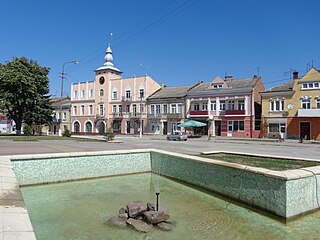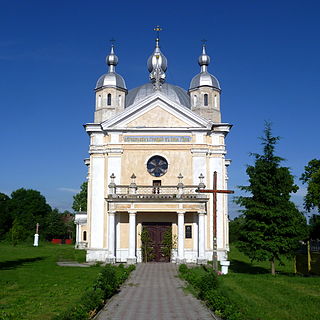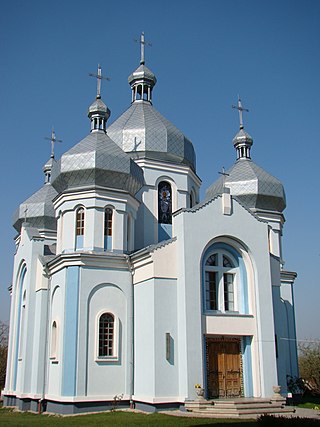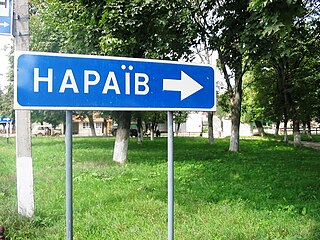
Sheptytskyi, formerly Chervonohrad, historically Krystynopol, is a mining city and the administrative center of Sheptytskyi Raion, Lviv Oblast of western Ukraine. It hosts the administration of Sheptytskyi urban hromada, one of the hromadas of Ukraine. Sheptytskyi lies about 62 km north of Lviv, 7 km from Sokal, 28 km northeast of the town of Voroniv, and has a population of 64,297.

Komarno is a city located in Lviv Raion (district) of Lviv Oblast (region) in western Ukraine. Local government is administered by Komarno City Council. It hosts the administration of Komarno urban hromada, one of the hromadas of Ukraine. The population is approximately 3,653.

Buchach is a city located on the Strypa River in Chortkiv Raion of Ternopil Oblast (province) of Western Ukraine. It hosts the administration of Buchach urban hromada, one of the hromadas of Ukraine. Buchach rests 135 kilometres south-east of Lviv, in the historic region of Halychyna (Galicia). The city was located in the Polish–Lithuanian Commonwealth until the partitions, followed by the Habsburg monarchy (1772–1804), Austrian Empire (1804–1867), Austria-Hungary (1867–1918), West Ukrainian People's Republic (1918–1919), the Second Polish Republic (1919–1939), and the Ukrainian SSR of the Soviet Union (1939–1991). The population was estimated at 12,171.

Zbarazh is a city in Ternopil Raion, Ternopil Oblast, western Ukraine. It is located in the historic region of Galicia. Zbarazh hosts the administration of Zbarazh urban hromada, one of the hromadas of Ukraine. Population: 13,346.

Rohatyn is a city located on the Hnyla Lypa River in Ivano-Frankivsk Raion, Ivano-Frankivsk Oblast, in western Ukraine. It hosts the administration of Rohatyn urban hromada, one of the hromadas of Ukraine. Population: 7,521.

Husiatyn is a rural settlement in Chortkiv Raion, Ternopil Oblast, western Ukraine. It hosts the administration of Husiatyn settlement hromada, one of the hromadas of Ukraine. Husiatyn is located on the west bank of the Zbruch River, which once formed the old boundary between Austria-Hungary and the Russian Empire in the 19th century, and the boundary between Poland and the Soviet Union during the 1920s and 1930s. The population is 7,032.

Khodoriv is a city in Stryi Raion, Lviv Oblast, western Ukraine. It hosts the administration of Khodoriv urban hromada, one of the hromadas of Ukraine. Its population is approximately 8,954.

Zhydachiv is a city in Stryi Raion, Lviv Oblast (region) in western Ukraine. It hosts the administration of Zhydachiv urban hromada, one of the hromadas of Ukraine. Local government is administered by the Zhydachiv City Council. Its population is approximately 10,353.

Terebovlia is a small city in Ternopil Raion, Ternopil Oblast, western Ukraine. Terebovlia hosts the administration of Terebovlia urban hromada, one of the hromadas of Ukraine. Population: 13,226 ; 13,661 (2001).

Pidhaitsi is a small city in Ternopil Raion, Ternopil Oblast, western Ukraine. It is located approximately 15.5 miles (24.9 km) south of Berezhany, 43.5 miles (70.0 km) from Ternopil, and 62 miles (100 km) south-east of Lviv. In 1939, Pidhaitsi obtained the formal status of a city. It hosts the administration of Pidhaitsi urban hromada, one of the hromadas of Ukraine. Population: 2,609.

Rava-Ruska is a city in Lviv Raion, Lviv Oblast, western Ukraine. It is a border town between Ukraine and Poland. The border checkpoint is situated 8 km (5 mi) west of the city, along the international autoroute Warsaw–Lviv. Rava-Ruska hosts the administration of Rava-Ruska urban hromada, one of the hromadas of Ukraine. Its population is approximately 8,494.

Tysmenytsia is a city in Ivano-Frankivsk Raion, Ivano-Frankivsk Oblast of western Ukraine. It hosts the administration of Tysmenytsia urban hromada, one of the hromadas of Ukraine. Population: 8,958.

Uhniv is a city in Sheptytskyi Raion, Lviv Oblast, western Ukraine. It has a population of 939 as of 2022.

Velyki Mosty is a city in Sheptytskyi Raion of Lviv Oblast (region) of western Ukraine. It hosts the administration of Velyki Mosty urban hromada, one of the hromadas of Ukraine. Its population is 6,286.

Iziaslav, also spelled Izyaslav or Zaslav is one of the oldest cities in Volhynia. Situated on the Horyn River in western Ukraine, the city dates back to the 11th century. Iziaslav belongs to Shepetivka Raion of Khmelnytskyi Oblast. It hosts the administration of Iziaslav urban hromada, one of the hromadas of Ukraine. Population: 15,296.

Kozova is a rural settlement in Ternopil Raion, Ternopil Oblast, western Ukraine. It is located in the historical region of Galicia, 16 km (10 mi) east of Berezhany, some 30 km (19 mi) west of Ternopil, and 100 km (62 mi) southeast of Lviv. It hosts the administration of Kozova settlement hromada, one of the hromadas of Ukraine. The settlement is situated beside a lake on the Koropets River. There is presumption that the name Kozova comes from the Ukrainian word koza (goat), though other possible sources exist. Population: 8,750.

Variazh is a village in Sheptytskyi Raion (district) of Lviv Oblast (province) in western Ukraine. Its population is 825 as of the 2024 Census. The village is located close to the border with Poland, near the Polish village of Uśmierz. It belongs to Sokal urban hromada, one of the hromadas of Ukraine.

Naraiv, also Narayiv, Narajiv is a selo in Ternopil Raion of Ternopil Oblast, Ukraine. It hosts the administration of Naraiv rural hromada, one of the hromadas of Ukraine.

Sheptytskyi Raion is a raion (district) of Lviv Oblast, Ukraine. It was known as Chervonohrad Raion from 2020 until 2024. The center of the raion is the city of Sheptytskyi. Population: 226,102.
Skomorokhy is a village in Chervonohrad Raion, Lviv Oblast of western Ukraine. It belongs to Sokal urban hromada, one of the hromadas of Ukraine.
































